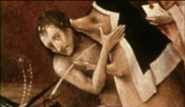Filmed by Jean Eustache for the television program, Les Enthousiastes, Hieronymous Bosch’s Garden of Delights presents a series of unstructured observations, free associations, and interpretations on the third panel of Bosch’s well-known oil on wood triptych by Eustache’s friend, Jean Frapat before a small captive audience. From the onset, Eustache creates a wry and playful ambiguity to Frapat’s dry intellectualism and occasionally untenable rumination, juxtaposing Frapat’s serious-minded struggle on the genesis of a vignette that shows a pig dressed in a nun’s habit (suggesting that an anthropomorphic transformation must have taken place before the captured moment), with the implicit humor of the sacrilegious image itself, then cutting to the shot of a woman with an enigmatic expression who then places her hand against her head, perhaps shifting unconsciously out of boredom or subtly expressing her own skepticism over the guest speaker’s tangential discourse. At times, Frapat’s observations are insightful, noting the absence of expression at moments of death and humiliation, the attribution of animal and mechanical characteristics to the human form, and the Freudian symbolism implicit in repeated acts of stabbing and piercing that dominate the panel. On other occasions, his drawn conclusions seem too ambitious and insupportable (most notably, in Frapat’s suggestion that the third triptych is replete with symbolic depictions of the seven human orifices – the six common to all humans, and the seventh, female – but cannot point out an instance of the seventh when challenged (perhaps, not surprisingly, by the same woman shown shifting her head near the beginning of the film), and instead, cuts the inquiry short by suggesting its vague ubiquity throughout the painting). It is interesting to note that while Frapat moves upward during his commentary from the amorous, habited pig in the lower corner, to the images of men fused with instruments, to the “ear cannon” that suggests the man-made nature of warfare, to the decimating conflagration the dominates the upper panel, Eustache films the panel in the opposite direction, incisively illustrating the cycle, not only of the grotesque dehumanization that comes with eternal damnation and the idea of humanity as self-perpetuating, tarnished mechanisms of abject life and death, but also of the interrogative – and provocative – nature of art itself.
© Acquarello 2008. All rights reserved.
